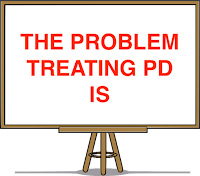There is no standard diagnostic test for PD only a collection of symptoms. There are four main motor symptoms - tremor, bradykinesia, rigidity, postural instability - and 10 or 11 secondary motor symptoms - freezing in place, unwanted acceleration, speech problems, micrographia (cramped handwriting that gets progressively smaller)- as well as 10 - 15 non motor symptoms - depression, anxiety, mood changes, fatigue, sleep problems, cognition problems, excessive saliva, etc. According to my neurologist, if you have three or more of the major symptoms you have PD.
Since everyone has a different collection of symptoms and each symptom shows to a different degree, the treatment for each person is different because the symptoms are what are addressed. Then the meds affect each of us differently. A med can help one person, make another hallucinate, and seem to have no affect on a third.
The real problem of course is that PD is progressive and there is no cure. It just gets worse. But in face of that many people with PD live their life as if they have the cure in their hands, they are the cure. They have taken the responsibility of improving their life upon themselves. They are not ignoring established PD medical practice. Seeing the doctor and taking pills is only one part of dealing with PD. I learned more about dealing with PD and managing my symptoms from fellow people with PD than I have from doctors. We are our own best resource. In fact, doctors seem genuinely interested in learning from me.
Most people with PD that I know are their own doctor making decisions as to how to best treat the disease. They consult with their friends in the PD community as well as their doctor. The latest research, how best to deal with and how to treat PD, is an ongoing active discussion topic among PWP.
There is always exciting news about possible cures and new treatments for Parkinson’s but everyday treatment is essentially the same since the 1960’s introduction of levodopa which is converted into dopamine in the brain. Modern research into gene therapy and stem cell treatments is promising but in 1817 in his “Essay On The Shaking Palsy” Dr. Parkinson’s predicted “Although, at present, uninformed as to the precise nature of the disease, still it ought not to be considered as one against which there exists no countervailing remedy. On the contrary, there appears to be sufficient reason for hoping that some remedial process may ere long be discovered, by which, at least, the progress of the disease may be stopped.” The good doctor described the disease well but had a little too much faith in the medical communities ability to stop the progression of or cure PD. It’s been 200 years and we are still uninformed as to the precise nature, there still is no cure, and nothing stops the progression of the disease. The best thing you can do is be healthy, take you meds as prescribed, exercise, and to enjoy and live your life.












